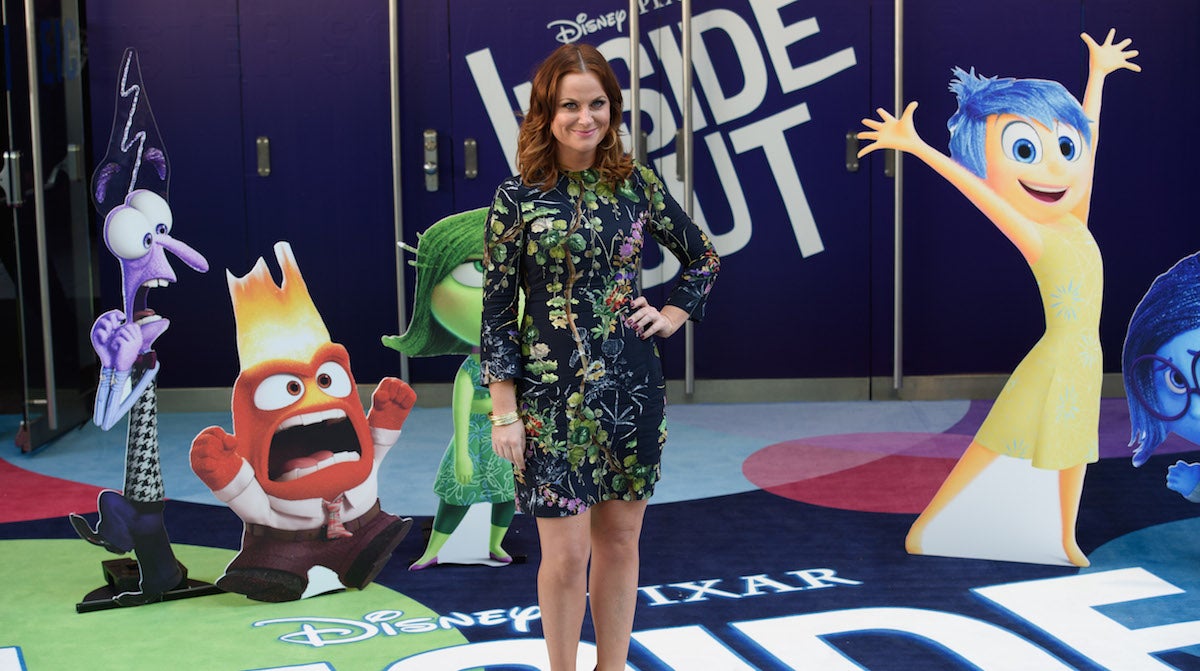4 things parents can learn from Disney’s ‘Inside Out’

Amy Poehler arrives for the UK screening of Inside Out at a central London cinema, London, Sunday, July 19, 2015. (Photo by Jonathan Short/Invision/AP)
I don’t want to sound like a curmudgeon or a pessimist, but I’m afraid the message of Disney and Pixar’s recent hit “Inside Out” may have gone over some parent’s heads.
Shall we review?
Didn’t we learn through the mind of 11-year-old Riley as she wrestled with the challenge of relocating from Minnesota to California for her dad’s job — unhappily leaving her friends and teammates behind — that sadness is not a contagious disease that we need to protect ourselves from?
Didn’t we find that when the emotion, Joy, was running around frantically trying to play keep away with the emotion Sadness (lest she touch Riley’s memories and ruin them for life), that this was unnecessary?
Wasn’t the moral of this story that when we lock sadness out of our awareness or quarantine it in a chalk circle away from the action, that bad things happen? Wasn’t it (spoiler alert) the character Sadness who ultimately saves the day?
Maybe we didn’t learn all of that, but it’s not too late.
Accepting sadness or anything other than delighted emotion may be a harder sell for parents in these helicopter days of swooping down to rescue our children from any discomfort we weren’t quick enough to prevent in the first place. Maybe our job description and our signal systems need some updating.
Instead of running sadness off the emotional property of our kids, we might try to find out more about what sadness knows and needs and wants.
Four lessons
Here are some things we can learn from the movie Inside Out:
It’s not normal to be happy all the time. It’s exhausting and a bit desperate. Though Amy Poehler, as the emotion Joy, is adorable and I would like her to be my best friend, she is frenetically attempting to plug up any speck of unhappiness. The urge to banish unhappiness in the movies or in real life is unsustainable, unnecessary and unhealthy.
Don’t be afraid of sadness. It’s normal, and even helpful. Scores of books have come out in the last decade cautioning against the pathologizing of sadness. Sadness is an inner memo that shouldn’t be hidden away, because it tells us that something important has happened. The sadness will come and it will go. It’s temporary. The worst thing that we can do is to feel like it’s a hot stove— that one touch it will singe us.
Sadness is a connector. Often sadness connects us to each other, which can lead to greater happiness. Without it, there are disconnects — between people and within one’s self. When Riley’s dear, but forgotten childhood imaginary friend Bing Bong, is upset that he is no longer relevant to her life, Sadness goes over to console him. Fearful that it will be a disaster like every other moment where Sadness gets involved, Joy tries to intervene before any more damage can be done. But what happens? Sadness sits down next to Bing Bong. “I’m sorry they took your rocket,” she quietly tells him, “That must have been hard.” As it turns out, Bing Bong just needed an empathic ear, and quickly feels better. Being understood in sadness — even if we can’t “fix” it — feels good, and helps people move forward.
Feelings are usually mixed. My favorite thing about “Inside Out” is that it will make my job as a cognitive-behavior therapist easier. When I tell my patients to picture a conversation in their mind between different emotions, the image of Riley’s emotions at the Headquarters control panel will quickly pop into their minds. I speak to kids every day about changing their relationship with their thoughts and emotions — engaging in a conversation between different parts of the brain so that no single part dominates, and each emotion gets to contribute.
Sometimes emotions can even collaborate. At the end of the movie, Joy has learned that Sadness is a valuable member of the team, and invites her over to the control panel so the two can operate it together. The result? A new kind of hybrid memory that is both happy and sad. Riley is crying as she misses home, but connecting with this feeling also brings a smile to her face — after all, it’s what brings her back to the people she loves.
Learning from sadness
Every time we see tears in our children’s eyes our inner control panel goes through the same process —we want to body dive sadness and get it off our kids — fast. I would say that this lesson to not fear our children’s sadness is the one that we have to relearn just about every time we see tears. I don’t want my kids to be sad.
But what’s my goal? Is it really to rescue them, wave the magic wand and make it all go away? Or is to help them connect to the important experience they are having — whether a big deal or a little deal— and instead integrate those emotions so they don’t cause an inner rift later.
This is the role we can do best as parents. It won’t be easy, but we have to remember that when our kids are sad, it’s not something that’s wrong, it’s something that’s real.
WHYY is your source for fact-based, in-depth journalism and information. As a nonprofit organization, we rely on financial support from readers like you. Please give today.

